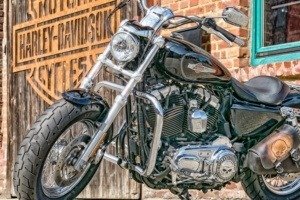
The iconic Harley Davidson brand has earned its place in history through grit, personality and determination

The year was 1903. One gentleman called William Harley and two Davidson brothers – Arthur and Walter – teamed up in a small garage in Milwaukee, Wisconsin to produce a motorbike. None of the three had vision nor aspiration to even imagine that they were building an iconic brand that represented the gung-ho, free, adventure spirit, so representative of American culture of yore. They built a rugged bike, found in the military their first major customer and as far as they were concerned, the story was over.
One of my most favourite brand videos of H-D is this. A man and a woman are making out in the bedroom of a house. A man on a H-D parks outside their house. The woman looks out of the window and whispers: it’s him. The man strides into the house, chucks his bike key on the table and enters the bedroom. The woman is waiting for him in a sexy come-hither pose. Even as he leans on her, the camera pans on to a photograph of a wedding picture and the first man hiding in the closet. It takes you a minute to figure out that the man hiding in the closet is the same one as in the wedding picture. He’s the husband now hiding in the closet even as Harley man makes out with his wife! And the logo flashes Harley Davidson and below that: Respect. And you smile at the audacity of this brand, telling you that in showing finger to rules and authority you are actually showing respect to Brand Harley!
Who then made it the brand that it is today? How did this whole transformation happen of H-D moving from motorbike business to ego business? How did H-D even come up with this weird customer profiling that their customers were wannabe closet rebels who dissed authority?
There is no one strategy or one dateline or one event that transformed H-D from a product to a cult status brand. Like I said, I don’t even know how the marketers of H-D figured out that their customer was a white middle aged, rich, bored, straitjacketed guy who was tossed around by his wife, boss and peers and who found not only his freedom in Harley but the freedom to show finger to people in positions of power! Was it a consciously articulated customer profiling or did it happen happenstance? Thus the Harley customers were always a community – and their disrespect for authority was not an individual act of defiance. It was collective finger-showing which was both their armour and their anthem.
I said Harley was in the ego business, right? So the motorbike was the mother node around which the entire satellite system of cult creation was built. Gears, apparel, tattoos, fan club, events, counter-culture, artefacts, ancillary industries… H-D didn’t just make a bike. It made a new human species. A Harley biker wasn’t just a bike rider. Like Amitabh Bachchan’s boast that wherever he stood, the queue would form right behind him, wherever the Harley biker rode, the sun came up on the horizon! And Harley used this emotional fulcrum to create multiple, imaginative, profitable, endearing, even aggressive, sources of revenue. It’s a phenomenal strategy that made more and more money on encouraging its members to embark on the long, rough, dusty road to rebellion.
Harley is all about lifestyle. It is all about emotional attachment. It is all about customers feeling that ‘we feeling’ with fellow Harley bikers. That’s how they survived memes about their fan club HOG (Harley Owners Group) whose membership the bikers owned and wore as a badge of honour. That’s how they overcame bad publicity of being the bike of choice for drug runners called Hells Angels! And that’s how being the biker badass became uber cool. Axe, the deodorant, even tried to piggy back on this when they launched their deo in a pack that looked suspiciously like bike motor oil! It celebrated the dreadlocked, body-inked, six packed, metal loaded dude who knew he was an outlaw and behaved like one, straight out of Louis L’Amour’s cowboy fiction. He was faster on the imaginary draw, needed no actual guns mister!
It’s interesting that even to this day, the senior management ride with their customers, on dirt tracks, in races, on regular terrains to understand them up-close and intimate, to take their chatter back to the drawing board and design an even better experience for them, time and time again. I also find it interesting that when the going got tough and the Japanese machines invaded their market, they sat around dissing the Japs, but not for long. You saw the whole team taking a leaf out of the Japs’ books and adopting just-in-time inventory, introducing quality circles, and launching GMP on an organization-wide scale and reinventing their brand. The HOGs came out all guns blazing to take over the market.
They figured somewhere along the way that the millennials were their emerging market. “We continue to sell more Harley-Davidson motorcycles to today’s young adults than we sold to Baby Boomers when they were young adults” asserts Harley CEO’. And now you have a page for women riders too on their website.
What more can you say about a brand that refuses to be anything but iconic? May the HOGs go forth and multiply!





